Dashboard Camera Market: Current Analysis and Forecast (2023-2030)
Emphasis on Technology Type (Basic, Advanced, and Smart.); Channel Type (Single Channel and Double Channel); Vehicle Type (Passenger Vehicle and Commercial Vehicle); and Region/Country
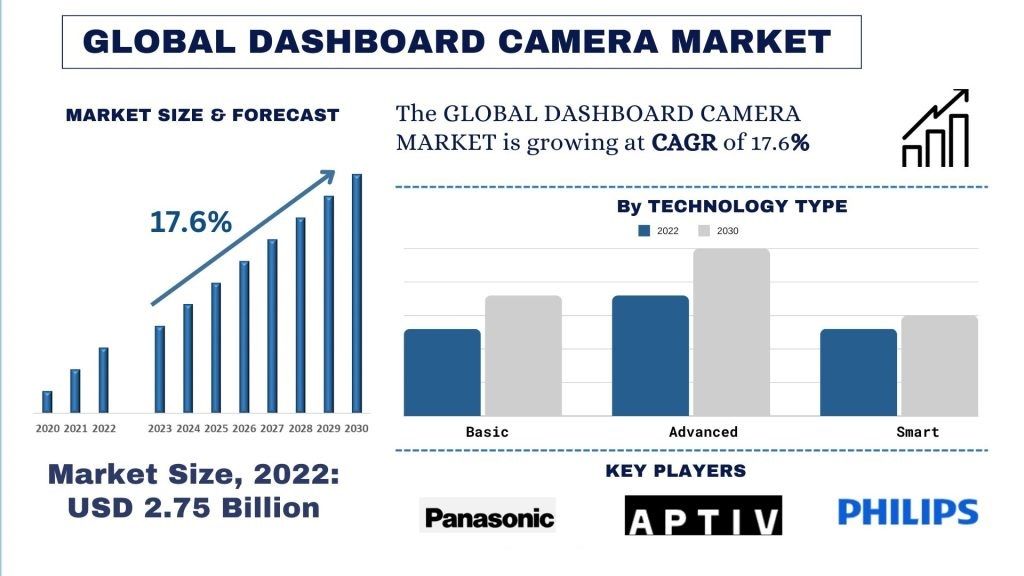
The Dashboard Camera Market was valued at 2.75 billion in the year 2022 and is expected to grow at a strong rate of around 17.6% during the forecast period (2023-2030), owing to the growing number of vehicles on roads and increasing road accidents.
Dashboard Camera Market Analysis
One of the key factors driving the demand for dashboard cameras is the increasing concern for road safety. As road accidents continue to be a major global issue, consumers are turning to dash cams as a way to provide evidence in the event of a crash or dispute. Furthermore, another factor contributing to the rising demand for dashcams is the growing awareness of insurance fraud and false claims. Dash cam footage can serve as crucial evidence in proving innocence and preventing insurance fraud, which has become a prevalent issue in many parts of the world. For instance, a study by the Insurance Fraud Bureau found that fraudulent insurance claims cost the UK insurance industry an estimated USD 1.41 billion in 2020. Moreover, the advancements in technology have made dashcams more affordable and user-friendly, further fuelling their demand in global markets. Many modern dashcams come equipped with features such as GPS tracking, G-sensors for impact detection, and cloud storage for easy access to footage. This has made dash cams not only a safety device but also a convenient tool for monitoring driving habits and vehicle security. Furthermore, the emergence of social media platforms and online communities dedicated to sharing dashcam footage has also contributed to the growing demand for these devices. Viral videos of near-misses, accidents, and unusual events captured by dashcams have garnered millions of views online, further popularizing the use of these devices among drivers.
Some of the major players operating in the market include Valeo; Aptiv; Honeywell International Inc.; Panasonic Corporation; Garmin Ltd; Koninklijke Philips N.V.,; DOD Tech; Waylens, Inc.; LG Innotek; and Pittasoft Co. Ltd. Several M&As along with partnerships have been undertaken by these players to facilitate customers with hi-tech and innovative products/technologies.
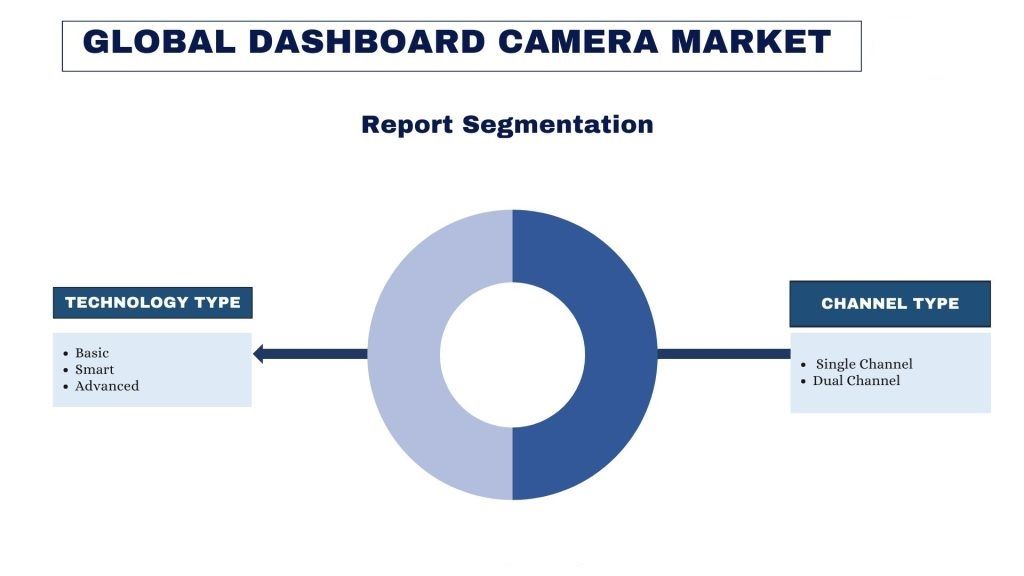 Dashboard Camera Market Trends
Dashboard Camera Market Trends
“Amongst technology types, the smart dashboard camera segment is anticipated to be the fastest growing segment during the forecast period (2023-2030).”
Based on technology type, the market is categorized into basic, advanced, and smart. The smart dashboard camera is anticipated to experience substantial growth in the predicted timeframe. The primary factor for this widespread adoption of the smart dashboard camera is its advanced features. Smart dashboard cameras come equipped with advanced features like GPS tracking, Wi-Fi connectivity, and smartphone integration. These features provide users with added functionalities and convenience, making smart cameras more appealing to consumers. Furthermore, Smart dashboard cameras often come with safety features such as lane departure warnings, collision detection, and real-time alerts. These features help drivers stay safe on the road, making smart cameras a popular choice among safety-conscious consumers. Moreover, Smart dashboard cameras can often store footage on the cloud, allowing users to access their recordings remotely. This feature is especially attractive to users who want to safeguard their recordings and access them from anywhere. Additionally, smart dashboard cameras can connect to other devices and applications, enhancing their overall functionality. Integration with smartphones, tablets, and other smart devices makes smart cameras more versatile and appealing to a wider range of consumers.
“Amongst vehicle type, the commercial vehicle is expected to generate the maximum demand for dashboard cameras during the forecast period (2023-2030).”
Based on vehicle type, the market is bifurcated into passenger vehicles and commercial vehicles. The demand for the dashboard camera is witnessing the fastest growth from the commercial vehicle segment. One of the primary factors fueling the demand for dashboard cameras is the need for enhanced safety measures. With the rise in road accidents and incidents involving commercial vehicles, fleet operators are increasingly turning to dashboard cameras to monitor driver behavior, identify risky driving practices, and prevent accidents. For instance, according to a report by the National Highway Traffic Safety Administration (NHTSA), 94% of accidents are caused by human error. Dashboard cameras can help mitigate these risks by providing concrete evidence in case of accidents and disputes. Furthermore, the growing importance of regulatory compliance is another driving factor behind the adoption of dashboard cameras in commercial vehicles. Mandates such as the Electronic Logging Device (ELD) rule in the U.S. and various safety regulations in the EU require commercial vehicles to maintain accurate records of driving hours and comply with safety standards. Dashboard cameras equipped with GPS tracking and driver monitoring features help fleet managers ensure compliance with these regulations and avoid penalties. In addition to safety and compliance, dashboard cameras are also being embraced for their role in improving operational efficiency and reducing costs for fleet operators. By providing real-time visibility into vehicle performance, fuel consumption, and route optimization, these cameras enable fleet managers to make informed decisions that lead to cost savings and enhanced productivity. For instance, according to some studies, fleet telematics solutions such as dashboard cameras can help reduce fuel consumption by up to 10% and decrease maintenance costs by 14%. Moreover, the increasing prevalence of insurance fraud and false claims has propelled the demand for dashboard cameras in commercial vehicles. In recent years, there has been a surge in fraudulent claims and staged accidents targeting commercial vehicles. Dashboard cameras serve as a reliable source of evidence to refute false claims and protect businesses from financial losses.
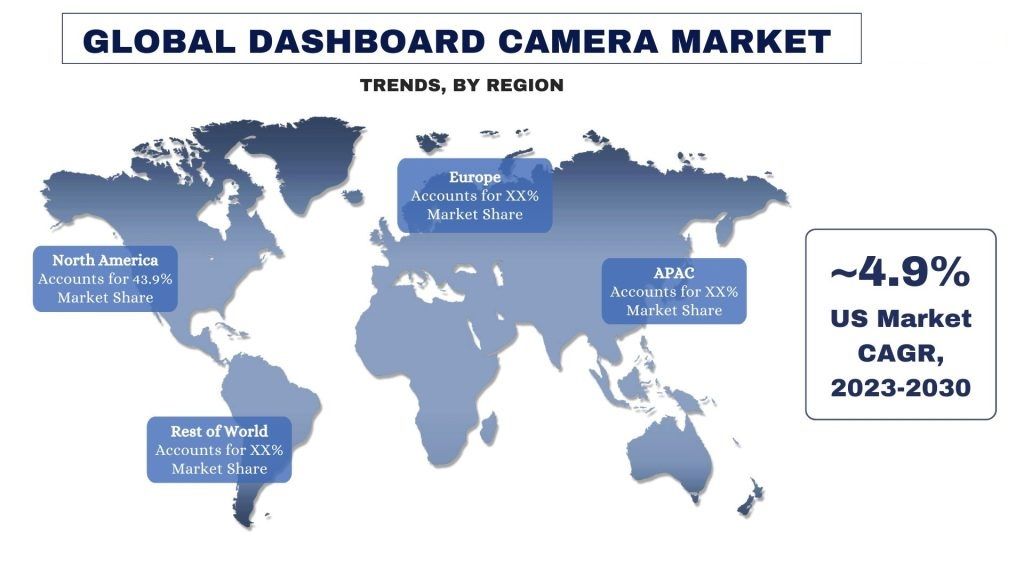
“North America held the significant share of the market in the year 2022.”
North America holds the majority of the market share. North America has been at the forefront of technological advancements, and the adoption of dashboard cameras is no exception. With a tech-forward consumer base and a culture that values innovation, North American drivers have readily embraced the use of dashboard cameras in their vehicles. Furthermore, safety and security are paramount for North American consumers, and dashboard cameras provide an added layer of protection on the roads. The prevalence of traffic accidents and fraudulent insurance claims has motivated drivers in North America to invest in dashboard cameras to capture crucial footage in case of incidents. For instance, the Insurance Institute for Highway Safety reported that in 2021, dashboard cameras helped resolve over 72% of disputed insurance claims in North America. Moreover, North America has a well-established legal framework that supports the use of dashboard cameras. In several states and provinces, including California and Ontario, dashboard camera footage is admissible in court as evidence in traffic-related cases. This legal support has encouraged drivers in North America to equip their vehicles with dashboard cameras, leading to a surge in market demand.
Dashboard Camera Market Report Coverage
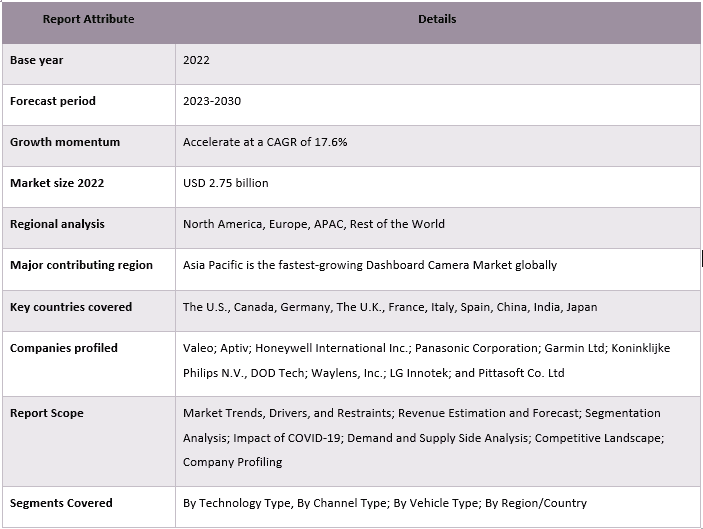
Reasons to buy this report:
- The study includes market sizing and forecasting analysis validated by authenticated key industry experts.
- The report presents a quick review of overall industry performance at one glance.
- The report covers an in-depth analysis of prominent industry peers with a primary focus on key business financials, product portfolios, expansion strategies, and recent developments.
- Detailed examination of drivers, restraints, key trends, and opportunities prevailing in the industry.
- The study comprehensively covers the market across different segments.
- Deep dive regional level analysis of the industry.
Customization Options:
The global Dashboard Camera market can further be customized as per the requirement or any other market segment. Besides this, UMI understands that you may have your own business needs, hence feel free to contact us to get a report that completely suits your requirements.
Table of Contents
Research Methodology for the Dashboard Camera Market Analysis (2023-2030)
Analyzing the historical market, estimating the current market, and forecasting the future market of the global Dashboard Camera market were the three major steps undertaken to create and analyze the adoption of Dashboard Camera in major regions globally. Exhaustive secondary research was conducted to collect the historical market numbers and estimate the current market size. Secondly, to validate these insights, numerous findings and assumptions were taken into consideration. Moreover, exhaustive primary interviews were also conducted, with industry experts across the value chain of the global Dashboard Camera market. Post assumption and validation of market numbers through primary interviews, we employed a top-down/bottom-up approach to forecasting the complete market size. Thereafter, market breakdown and data triangulation methods were adopted to estimate and analyze the market size of segments and sub-segments of the industry pertains to. Detailed methodology is explained below:
Analysis of Historical Market Size
Step 1: In-Depth Study of Secondary Sources:
A detailed secondary study was conducted to obtain the historical market size of the Dashboard Camera market through company internal sources such as annual reports & financial statements, performance presentations, press releases, etc., and external sources including journals, news & articles, government publications, competitor publications, sector reports, third-party database, and other credible publications.
Step 2: Market Segmentation:
After obtaining the historical market size of the Dashboard Camera market, we conducted a detailed secondary analysis to gather historical market insights and share for different segments & sub-segments for major regions. Major segments are included in the report as technology type, channel type, and vehicle type. Further country-level analyses were conducted to evaluate the overall adoption of testing models in that region.
Step 3: Factor Analysis:
After acquiring the historical market size of different segments and sub-segments, we conducted a detailed factor analysis to estimate the current market size of the Dashboard Camera market. Further, we conducted factor analysis using dependent and independent variables such as technology type, channel type, and vehicle type of the Dashboard Camera market. A thorough analysis was conducted of demand and supply-side scenarios considering top partnerships, mergers and acquisitions, business expansion, and product launches in the Dashboard Camera market sector across the globe.
Current Market Size Estimate & Forecast
Current Market Sizing: Based on actionable insights from the above 3 steps, we arrived at the current market size, key players in the global Dashboard Camera market, and market shares of the segments. All the required percentage shares split and market breakdowns were determined using the above-mentioned secondary approach and were verified through primary interviews.
Estimation & Forecasting: For market estimation and forecast, weights were assigned to different factors including drivers & trends, restraints, and opportunities available for the stakeholders. After analyzing these factors, relevant forecasting techniques i.e., the top-down/bottom-up approach were applied to arrive at the market forecast for 2030 for different segments and sub-segments across the major markets globally. The research methodology adopted to estimate the market size encompasses:
- The industry’s market size, in terms of revenue (USD) and the adoption rate of the Dashboard Camera market across the major markets domestically
- All percentage shares, splits, and breakdowns of market segments and sub-segments
- Key players in the global Dashboard Camera market in terms of products offered. Also, the growth strategies adopted by these players to compete in the fast-growing market.
Market Size and Share Validation
Primary Research: In-depth interviews were conducted with the Key Opinion Leaders (KOLs) including Top Level Executives (CXO/VPs, Sales Head, Marketing Head, Operational Head, Regional Head, Country Head, etc.) across major regions. Primary research findings were then summarized, and statistical analysis was performed to prove the stated hypothesis. Inputs from primary research were consolidated with secondary findings, hence turning information into actionable insights.
Split of Primary Participants in Different Regions
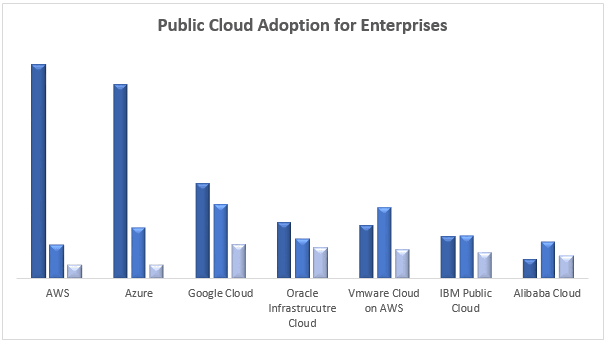
Market Engineering
The data triangulation technique was employed to complete the overall market estimation and to arrive at precise statistical numbers for each segment and sub-segment of the global Dashboard Camera market. data was split into several segments & sub-segments after studying various parameters and trends in the areas of purity and application in the global Dashboard Camera market.
The main objective of the Global Dashboard Camera Market Study
The current & future market trends of the global Dashboard Camera market were pinpointed in the study. Investors can gain strategic insights to base their discretion for investments on the qualitative and quantitative analysis performed in the study. Current and future market trends determined the overall attractiveness of the market at a regional level, providing a platform for the industrial participant to exploit the untapped market to benefit from a first-mover advantage. Other quantitative goals of the studies include:
- Analyze the current and forecast market size of the Dashboard Camera market in terms of value (USD). Also, analyze the current and forecast market size of different segments and sub-segments.
- Segments in the study include areas of technology type, channel type, and vehicle type.
- Define and analyze the regulatory framework for the Dashboard Camera
- Analyze the value chain involved with the presence of various intermediaries, along with analyzing customer and competitor behaviors of the industry
- Analyze the current and forecast market size of the Dashboard Camera market for the major region
- Major countries of regions studied in the report include Asia Pacific, Europe, North America, and the Rest of the World
- Company profiles of the Dashboard Camera market and the growth strategies adopted by the market players to sustain in the fast-growing market
- Deep dive regional level analysis of the industry
Frequently Asked Questions FAQs
Q1: What is the current market size and growth potential of the global Dashboard Camera market?
Q2: What are the driving factors for the growth of the global Dashboard Camera Market?
Q3: Which segment is the fastest growing of the global Dashboard Camera market by technology type?
Q4: What are the emerging technologies and trends in the global Dashboard Camera market?
Q5: Which region will be the fastest-growing global Dashboard Camera market?1
Q6: Who are the key players in the global Dashboard Camera market?
Related Reports
Customers who bought this item also bought










